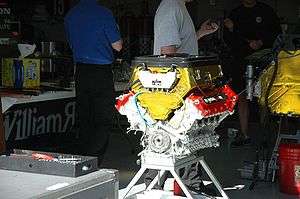Honda Indy V8
| Honda Indy V8 | |
|---|---|
 a 2007-spec Honda Indy HI7R V8 engine | |
| Overview | |
| Manufacturer | HPD-AHM Co. |
| Production | 2003-2011 |
| Combustion chamber | |
| Configuration | V8 naturally-aspirated, 90° cylinder angle |
| Displacement |
3,500 cc (3.5 L; 213.6 cu in) (2003, 2007-2011) 3,000 cc (3.0 L; 183.1 cu in) (2004-2006) |
| Cylinder bore | 93 mm (4 in) |
| Cylinder block alloy | Aluminum alloy |
| Cylinder head alloy | Aluminum alloy |
| Valvetrain | 32-valve, DOHC, four-valves per cylinder |
| Combustion | |
| Turbocharger | No |
| Fuel system | Electronic indirect fuel injection |
| Management | Motorola |
| Fuel type | 100% fuel grade Ethanol provided by Sunoco |
| Oil system | Dry sump |
| Output | |
| Power output | 650 hp (485 kW) + 40 hp (30 kW) with push-to-pass |
| Torque output | Approx. 430 N·m (317 ft·lbf) @ 8000 rpm |
| Dimensions | |
| Dry weight | 280 lb (127 kg) - no headers, clutch, ECU, spark box or filters |
| Chronology | |
| Predecessor | Honda Turbo V8 |
| Successor | Honda Indy V6 |
The Honda Indy V8 engine is a 3.5-litre naturally-aspirated V8, developed and produced by HPD-AHM Co. for IndyCar Series. Honda Indy V8 was a highly-successful IndyCar Series engine supplier from 2003 to 2011 seasons before replaced by Honda Indy V6 at the following season. Honda Indy V8 was unveiled at 2002 Detroit Auto Show and assembled at HPD power assembly plant in Santa Clarita, California, USA in early 2003.
1st Generation (2003-2004)
Honda debuted IndyCar Series as engine supplier in 2003 season after a CART successful era. Developed by Ilmor and designated as HI3R, engine's capacity was 3.5-liter. Honda supplied Andretti Green Racing, Team Rahal, Fernández Racing and Access Motorsports teams. Honda's 2003 stats were 3 pole positions, 6 fastest laps and 2 wins. A revised engine named HI4R was used in 2004 until new regulations came into effect at the 2004 Indianapolis 500.[1]
Applications
- Dallara IR3
- G-Force GF09
2nd Generation (2004-2006)
Honda designed a new engine to address the 2004 IRL rule change which required reduced displacement. Developed once again by Ilmor and designated as HI4R-A,[2] its capacity was 3.0-liter and debuted at the 2004 Indianapolis 500.[3] With subsequent evolutions named HI5R and HI6R, Honda was clearly dominant engine, scoring 33 poles, 35 fastest laps, 41 wins totally in three seasons including 3 Indianapolis 500s. Since Chevrolet and Toyota leaves IndyCar Series after 2005 season, Honda won exclusive tender IndyCar Series engine supplier for 2006 to 2011 season.
Applications
- Dallara IR4
- Panoz GF09B
- Panoz PZ09C
3rd Generation (2007-2011)
This family was designed as a replacement for the HI6R but enlarged to better accommodate variable valve timing and Active Fuel Management while still generating good performance. HI7R-HI11R's capacity reverted to 3.5-liters respectively since 2007 season.[4] HI7R-HI11R engine was developed by Honda in Tochigi, Japan and assembled from delivery in Santa Clarita, California, USA (Honda Performance Development's current headquarters). HI7R-HI11R engine supplied for all IndyCar Series teams. HI7R-HI11R was highly-successful engine with 86 pole positions, fastest laps and wins respectively including 2008 Nikon Indy 300 exhibition race and 5 Indianapolis 500s. Due to the IndyCar Series chassis and engine development freeze beginning in 2008, IndyCar Series kept the Honda HI7R-HI11R model until 2011 season for cost reasons.
During that time, since the IndyCar Series had only one engine manufacturer, Honda focused on minimizing engine failure and minimizing costs instead of defeating rivals. As such, the engines were moderately de-tuned. The engines proved themselves to be quite durable. There had been no engine failures at Indy from 2006 to 2010, which also lowered the number of crashes. Most of the engines, including those used for the Indy 500, were used for multiple races and were intended to last 1,200 miles (1,931 kilometers) between rebuilds.[5] The Honda engines were only available via lease arrangement from Honda, which, for the 2010 full season, cost $935,000 U.S. per season, per car.[6]
The HR7R-HR11R were rev-limited to 10,300 rpm and produced approximately 650 hp. The valve train is a dual overhead camshaft configuration with four valves per cylinder. The crankshaft is made of alloy steel, with five main bearing caps. The pistons are forged aluminum alloy, while the connecting rods are machined alloy steel. The electronic engine management system is supplied by Motorola, firing a CDI ignition system. The engine lubrication is a dry sump type, cooled by a single water pump.
Year 2011 final specifications
- Engine type: Normally-aspirated, fuel-injected, aluminium alloy cylinder block V-8
- Displacement: 3.5 litres (213.6 cubic inches)
- Valve train: Dual overhead camshaft, 4 valves per cylinder
- Crankshaft: Alloy steel, 5 main bearing caps
- Pistons: Forged aluminium alloy
- Connecting rods: Machined alloy steel
- Lubrication: Dry sump
- Cooling: Single water pump
- Engine management: Motorola
- Ignition: CDI[7]
Applications
- Dallara IR5
Honours
On February 10, 2012 Honda Indy V8 was honoured as "North American Race Engine of the Year" by Race Engine Magazine.[8]
References
- ↑ "Indy: Honda's 2004 Engine". HondaBeat.com. September 10, 2004.
- ↑ "2004 Indy 500: BorgWarner Louis Schwitzer Award Presented to Honda". The Auto Channel. May 21, 2004.
- ↑ "Honda Unveils Stout Lineup to Defend IRL Titles". Honda Motor Co. January 19, 2005.
- ↑ "IRL to revert to 3.5-litre engines". Autosport. Autosport.com. August 31, 2006. Retrieved August 31, 2006.
- ↑ Reitz, Victoria (2006-05-25). "Leveling the playing field". MachineDesign.com. Retrieved 2003-04-13.
- ↑ "IndyCar confirms rule changes, cost savings". Racer.com. 2010-01-12. Retrieved 2010-08-23.
- ↑ https://web.archive.org/web/20071112123503/http://www.indycar.com/tech/images/honda-engine.jpg
- ↑ "Honda Indy V8 Honored by Race Engine Magazine". http://www.honda.com. 2012-02-10. Retrieved 2012-02-10. External link in
|publisher=(help)